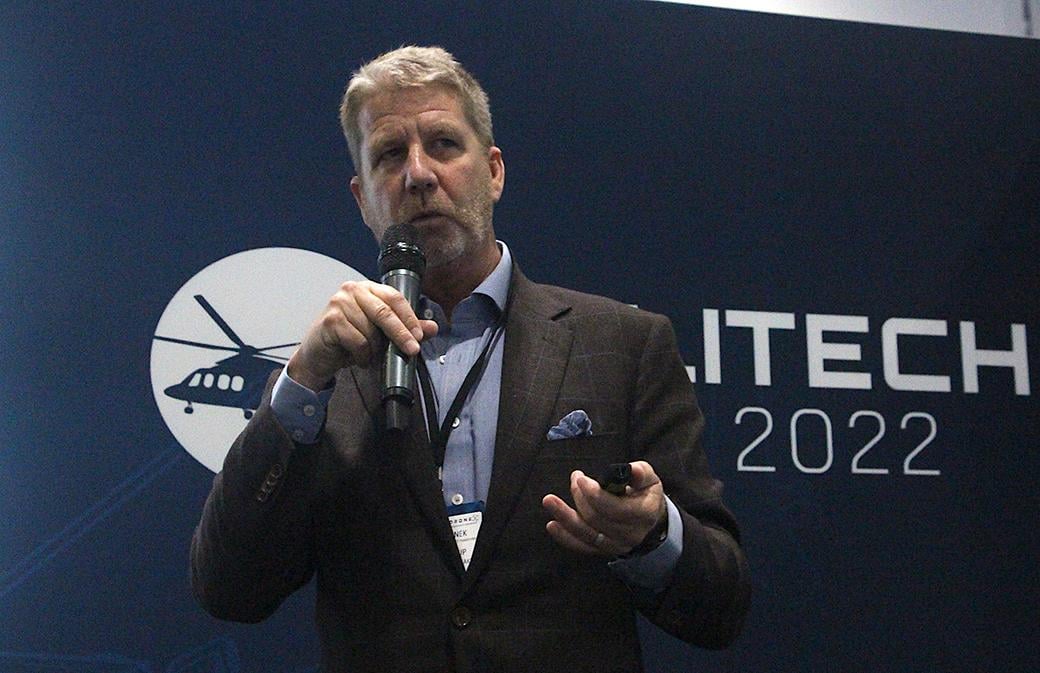
“Much of the focus in advanced air mobility today—and rightly so—has been on the vehicle,” says David Stepanek, the Bristow Group’s chief transformation officer. “There hasn’t been a lot of focus, or any focus at all, on what happens after production: who operates them, how we operate them, where we operate them, [for] what applications.”
Stepanek used his presentation to the Helitech/DroneX Expo in London to begin to reset that balance. Bristow, with a global fleet of 222 aircraft, which represents roughly $1 billion on the company’s balance sheet, has made significant investments in AAM.
The company has signed contracts with seven AAM OEMs, including Eve Holding, Vertical Aerospace and unmanned cargo-platformer Elroy Air. This is not simply a case of the helicopter specialist spreading its bets as it seeks an early foothold in AAM operations, though Stepanek admits being among the first to market is as an ambition. Mainly, he says, Bristow sees different aircraft operating in different roles.
“We have a lot of different helicopters; they operate in different markets and different applications,” he says. “Right now, we’re engaged with seven [AAM] OEMs. We chose them for very specific reasons, and we believe they fit our business model with what we want to do.”
Just as importantly, Stepanek says, the company views the new technologies as complementing its existing fleets, not as providing direct replacements for traditional rotorcraft.
“We’re not going to go out there and replace large helicopters flying offshore, but [intend to take] a parallel path,” Stepanek explains. “If I were Sikorsky or Airbus or Leonardo right now, I wouldn’t be too concerned about losing business. But if I were a trucking company or a rail company or even a ship company, I would be concerned that there’s going to be opportunities for us to move people differently and move stuff differently.”
With the platforms in development, operational concepts still are taking shape, but one thing Bristow has decided is it will operate its inhabited platforms with crews on board.
“Every one of the business models that we’ve built for AAM—except for the Elroy aircraft, which is remotely piloted—will be crewed,” Stepanek says. “I understand the cost structure of a pilot, and I understand the complexities that are involved. But when you compare these aircraft to traditional piloted helicopters, the cost difference is so substantial that we can make this work commercially with pilots.”
The new platforms’ lower acquisition and operating costs are designed to allow operators to acquire larger fleets, which will be required if they are to provide the shuttle and taxi services the emerging sector promises. The anticipated staffing levels are substantial. Stepanek outlines internal research which suggests a regional operating model covering an area such as the Florida peninsula “would take as many pilots and engineers to support it as our entire global company today.” Pilot training will be a critical factor limiting uptake.
“Yes, it’s a problem,” he says. “It’s a problem that needs to be solved. It’s a problem we need to work on with the regulatory authorities. We intend, through government affairs and really through proving it pragmatically, [to demonstrate] we can train people. I do believe it’s going to have to be a competency-based training program versus kind of the obligatory numbers of hours that we have today.”
Bristow is looking at building its own in-house training system in advance of receiving any AAM platforms, to familiarize staff with electric-aircraft operations.
“One of the things that I plan to do is to buy some electric aircraft that are existing today and get our pilots and our engineers used to the propulsion systems and charging systems, and do that in a Part 91 operation—just to prove it out,” Stepanek says.
Encouragingly, Stepanek expects early experience in OEM simulators will ease training people to fly the new generation of aircraft and shorten the path to proficiency than for traditional rotorcraft. If regulatory pathways can be agreed, the sector should be able to recruit the huge numbers of pilots likely to be required, he believes.
“I’ve flown the Volocopter aircraft, the Beta aircraft and the Vertical aircraft simulators,” Stepanek says. “I’ve been there with some of our professional pilots, and I’ve been there with our general counsel, and the general counsel flies it better. [The new platforms are] not intuitive to a pilot today. It’s not stick-and-rudder skills. It’s up, down, forward, back, and it’s quick and easy. I think it’s going to be more about airmanship and decision-making than piloting skills.”





